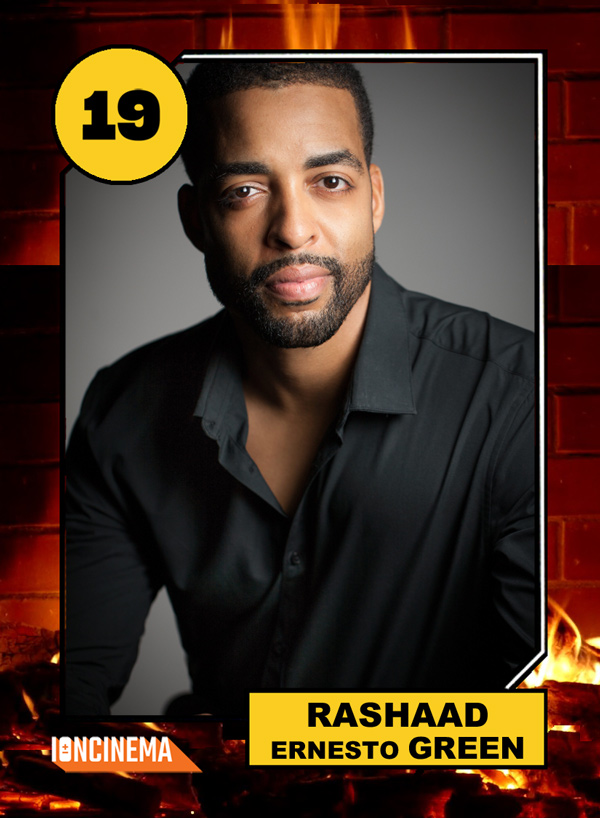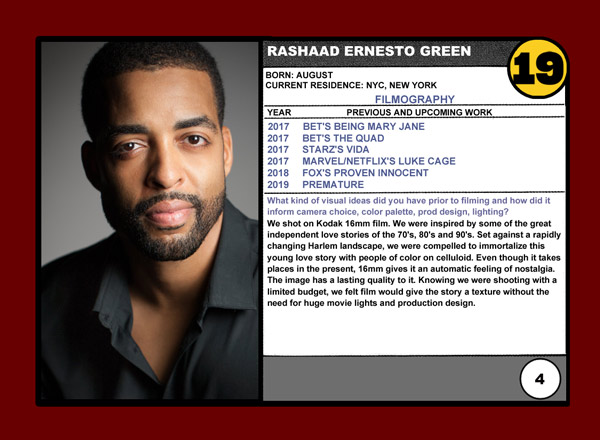Filmmaker Rashaad Ernesto Green from Premature is among the voices, faces and creative folks that are a part of the ten films selected for our favourite section at the Sundance Film Festival. Added to the fest at the beginning of the decade, over time, the NEXT section (formerly referred to as “<=>”) has unearthed some of the best voices in micro American indie film projects with the likes of Sebastian Silva, Josh Mond, Rick Alverson, Anna Rose Holmer, Andrew Dosunmu, Craig Zobel, David Lowery and Janicza Bravo. We return with Sundance Trading Card Series focusing on the 2019 NEXT section selected films and personalities.
Eric Lavallee: Name me three of your favorite “2018 discoveries”.
Rashaad Ernesto Green:
1. Gustav Möller’s The Guilty
2. Cali, Colombia, Salsa capital of the world
3. Pollo Sudado, an exquisitely delicious dish, also in Cali, Colombia.

Lavallee: Prior to committing to the project, could you discuss the first gist of an idea (e.g. setting, visual idea, character, plot device, personal experience) and how that evolved or help push the project forward?
Green: After the success of my short film PREMATURE, my dear friend Zora Howard (who starred in the short at age 14, and who I first met when she was 11) and I had been talking about working together again for years. Two years ago, we finally decided to write something together with the intention that she would star in it and I’d direct it. We didn’t know what we would write about until we sat down together. We threw out a bunch of ideas, but we paid close attention to what we both felt was missing in black cinema. We felt there was an overabundance of black films with narratives driven by playing the race card with themes of black victimization, black fear, black pain and black death. Although we understood the impulse to explore these narratives, we wanted to do something different with this film. We decided instead to explore black life and black love. In the current cinematic climate, we viewed simply telling a young black love story as a radical act. It wasn’t until writing it that themes from the short film began to influence us and find their way into the story.
Lavallee: What characteristics, traits, mannerisms, were you looking for in your lead player? Could you detail that DNA and how they relate to the world around them?
Green: Our protagonist Ayanna is played by my friend and co-writer Zora Howard, both born and raised in Harlem, New York. There’s a rhythm to Harlem, a beat only Harlemites walk, a cadence of speech only Harlemites talk. You have to be here awhile to pick up on it. It’s that DNA that our lead character Ayanna needed to live and breathe to make this story come to life. Lucky for us, Zora had it in spades.
Lavallee: For those familiar with your work, is there an overlap with a specific prior example and if so, how does this relate to your concerns, obsessions, curiosities, and/or style?
Green: Ten years after the short film PREMATURE, the story morphed into something more complex and beautiful. I often deal with the angst of young people of color in my work. This time, the young woman was a little older, a little wiser, but still not fully knowing. Ayanna isn’t necessarily aware that’s she’s on a journey towards self-discovery and self-actualization. She’s thrust into a situation that forces her to grow, whether she’s aware of it or not. The ups and downs of love in a young person’s life can bring the greatest joy as well as the greatest pain, and sense of loss and longing. Ayanna may not be ready for this lesson when we begin the film, but she grows into herself as we progress. And such is life. In many instances, we’re not ready for the journey we find ourselves on, but we often persevere and grow as a result.
Lavallee: What kind of visual ideas did you have prior to filming and how did it inform camera choice, color palette, prod design, lighting?
Green: We shot on Kodak 16mm film. We were inspired by some of the great independent love stories of the 70’s, 80’s and 90’s. Set against a rapidly changing Harlem landscape, we were compelled to immortalize this young love story with people of color on celluloid. Even though it takes places in the present, 16mm gives it an automatic feeling of nostalgia. The image has a lasting quality to it. Knowing we were shooting with a limited budget, we felt film would give the story a texture without the need for huge movie lights and production design.
Lavallee: In terms of ambient sound, score, silence, beats, how does your sound design choices inform the film in terms of tone, atmosphere, emotional in/output?
Green: Sound design plays an extremely important role in our film. There are some very quiet moments, but it’s never quite silent. Harlem never fully dies. It’s always alive in some way. Even in the dead of night, you might hear a dog barking, siren wailing or bus screeching in the distance. We used these sounds sparingly and subconsciously to evoke an emotional response when necessary.
Click to expand!



